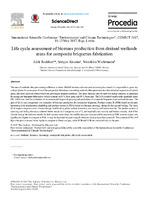Life cycle assessment of biomass production from drained wetlands areas for composite briquettes fabrication
Bibliographic entry
Rodzkin, A. I. Life cycle assessment of biomass production from drained wetlands areas for composite briquettes fabrication / A. I. Rodzkin, S. P. Kundas, W. Wichtmann // Energy procedia. – 2017. – Vol. 128. – P. 261-267.
Abstract
The area of wetlands after peat mining in Belarus is about 190,000 hectares and once peat harvesting has ceased it is impossible to grow any cultural plants for some years. One of the perspective directions is rewetting wetlands after peat extraction that stimulate vegetation of natural grass, like reed, rush and others which are growing in natural conditions. The grass biomass may be used for energy purpose, in particular for composite briquettes fabrication, which contents in 50 % from grass and 50 % from peat. The LCA method based on the standards series ISO 14040 was used for evaluation of environmental impact of growing and production of composite briquettes from wetland biomass. The goal of LCA was comparison two scenarios of biomass production for composite briquettes. Product system B (PSB) based on biomass harvesting with simultaneous shredding and product system A (PSA) based on biomass mowing, raking for drying and bailing. The basic LCA impact categories were: climate change, acidification, photo oxidant formation, eco toxicity and human toxicity. The product system A (mowing and baling biomass) achieved better results in 3 categories out of 5, and especially eco toxicity and human toxicity. And if for climate change the indicator results for both systems were close, for acidification, eco toxicity and human toxicity PSB systems impact was significantly higher to compare to PSA. It may be explained by peat using for biomass drying in product system B. The contents of SO2 and Hg in the peat in several times higher to compare to diesel and gas, while PCB and GCB are contained only in the peat.

